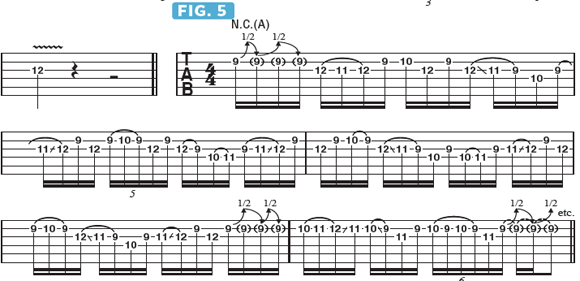Marty Friedman Lesson: How to Develop Melodic Ideas with Interesting Twists
Learn how to take a basic melodic idea and morph it into something more nuanced and complex.

If I had to pick one thing I place highest in importance when it comes to guitar playing, it would be originality.
I am not a fan of the tried-and-true cliché licks that have been used forever by so many guitarists. To me, it’s simply a cop out to mimic fast phrases or standard rock licks that we’ve all heard a million times before. I think it’s much more interesting and appealing to strive for originality through spontaneity and invention.
Why play the same lick as someone else when you can express your own distinct musical personality through an idea of your own?
Last month, I demonstrated a variety of ways in which to employ string-bending techniques in order to personalize a melodic phrase. Let’s now expand on this concept by taking a similar basic melodic idea and gradually morphing it into lines that become a bit more complex and nuanced.
In FIGURE 1, instead of simply fretting each note of a melodic line, I repeatedly bend up to “target” notes from a half step below, starting with D# bent up to E, and followed by G# bent up to A. Notice that I use a bend-release-bend articulation device.
These quick “pitch shifts” emulate the wavering of the human voice and afford me the opportunity to build a more distinct character into the articulation of the phrase. Bar 1 ends with a quick pull-off and slide down the B string, followed by a trill (a quickly repeating hammer-on and pull-off) between the A root note and G#, the major seventh.
The phrase concludes with a pull-off from F, the flatted sixth, to E, the fifth. A cool, simple variation on this idea can be applied by changing the flatted sixth to either the major, or natural, sixth, F#, or the flatted seventh, G, as FIGURE 2 demonstrates.
All the latest guitar news, interviews, lessons, reviews, deals and more, direct to your inbox!
The first three bars of FIGURE 3 illustrate a way I might switch back and forth between F# and G on the G string while utilizing similar hammer-pull-bend ideas on the B string. At the end of bar 3, I ramp things up a bit by including ascending and descending chromaticism on the B string and then begin the last bar of the phrase by moving the G#-to-A trill up one half step, from A to Bb. The phrase ends with a vibrato-ed whole-step bend on the G string, from G to A.
My natural approach in the interpretation of this melody would be to continually look for interesting ways to expand on the basic phrase, as illustrated in FIGURES 4 and 5. In bar 2 of FIGURE 4, I include the notes of an A major triad, A C# E, and in FIGURE 5 I place the focus on fast chromatic shapes that move between F#, G, G# and A.
Now that you have the idea, try incorporating these articulation devises into every melody you play. You’ll be amazed at what you come up with!


